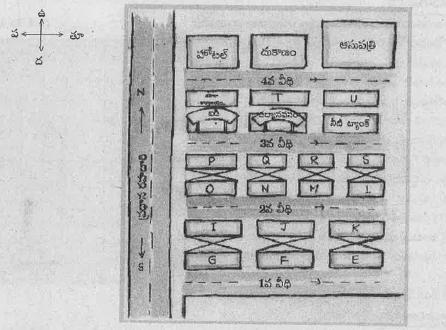కింద ఇవ్వబడిన బాహుపదులలో సూచించిన చరరాశి విలువను ప్రతిక్షేపించి విలువలు కనుగొనండి. y=1వద్దq(y)=2y3−4y+√11
Step by step video & image solution for కింద ఇవ్వబడిన బాహుపదులలో సూచించిన చరరాశి విలువను ప్రతిక్షేపించి విలువలు కనుగొనండి. y=1 వద్ద q(y)=2y^(3)-4y+sqrt 11 by Maths experts to help you in doubts & scoring excellent marks in Class 9 exams.
Updated on:21/07/2023Topper's Solved these Questions
- బహుపదులు మరియు కరణాంకా విభజనBOOK - VGS PUBLICATION-BRILLIANT(TELUGU)CHAPTER - బహుపదులు మరియు కరణాంకా విభజనEXERCISE - Exercise
208 Videos
- నిరూపక జ్యామితిBOOK - VGS PUBLICATION-BRILLIANT(TELUGU)CHAPTER - నిరూపక జ్యామితిEXERCISE - Exercise
87 Videos
- రెండు చరరాశులలో రేఖీయ సమీకరణాలుBOOK - VGS PUBLICATION-BRILLIANT(TELUGU)CHAPTER - రెండు చరరాశులలో రేఖీయ సమీకరణాలుEXERCISE - Exercise
180 Videos
Similar Questions
కింద ఇవ్వబడిన ప్రతి బాహుపది యొక్క పరిమాణం కనుగొనండి. x5−x+3
View Solutionఒక ఆవాస ప్రాంతంలో ప్రధాన రహదారి ఉత్తర-దక్షిణ దిశలలో ఉంది. దాని పటం కింది ఇవ్వబడినది. పటం సహాయంతో కింది ప్రశ్నలకు సమాధానాలు వ్రాయండి.
 తూర్పుదిక్కున వెళ్లునప్పుడు మూడవవీధిలో ఎడమవైపు మూడోవస్థానంలో ఏం ఉంది?
తూర్పుదిక్కున వెళ్లునప్పుడు మూడవవీధిలో ఎడమవైపు మూడోవస్థానంలో ఏం ఉంది?
View Solutionకింది రేఖాసమీకరణలను ax+by+c=0 రూపంలో రాసి, ప్రతి సందర్భంలోను a,b మరియు c విలవును రాయండి. 3x+2y=9
View SolutionGiven that (1+sqrt(1+y))tan y = 1+sqrt(1-y) Then sin 4y is equal to: a) 4y b) 2y c) y d) none of these
View SolutionIf y=√x+√y+√x+√y+∞,thenprovethatdydx=y2−x2y3−2xy−1
View SolutionIf y=sqrt(x+sqrt(y+sqrt(x+sqrt(y+...oo))) then ) prove that (dy)/(dx)=(y^(2)-x)/(2y^(3)-2xy-1)
View SolutionIf y+12y=4 , then find y2+14y2
View SolutionSolve: (y-(4-3y))/(2y-(3+4y))=(1)/(5)
View SolutionIf y=(sqrt(3)+1)/(2) then find the value of 4y^(3)+2y^(2)-8y+10=
View Solutionకింది బాహుపదులలో P(0),p(1)మరియుp(2)విలువలుకనుగొనుము.p(y)=2+y+2y^(2)-y^(3)
View Solutionp(y)=4y3+4y2−y−1 అను బాహుపది (2y+1) నకు గుణిజం అవుతుందా? సరిచూడండి.
View SolutionCheck whether the polynomial p(y)=4y3+4y2−y−1 is a multiple of (2y+1).
View SolutionCheck whether the polynomial p(y)=4y3+4y2−y−1 is a multiple of (2y+1).
View SolutionCheck whether the polynomial p(y)=4y3+4y2−y−1 is a multiple of (2y+1).
View SolutionCheck whether the polynomial p(y)=4y3+4y2−y−1 is a multiple of (2y+1).
View Solution
